Patching Perforce perforations: Critical RCE vulnerability discovered in Perforce Helix Core Server
Credit to Author: Microsoft Threat Intelligence| Date: Fri, 15 Dec 2023 17:00:00 +0000
Microsoft discovered, responsibly disclosed, and helped remediate four vulnerabilities that could be remotely exploited by unauthenticated attackers in Perforce Helix Core Server (“Perforce Server”), a source code management platform largely used in the videogame industry and by multiple organizations spanning government, military, technology, retail, and more. Perforce Server customers are strongly urged to update to version 2023.1/2513900, available here: https://www.perforce.com/downloads/helix-core-p4d. The most critical of the four vulnerabilities has a CVSS score of 10.0 because it allows for arbitrary remote code execution as LocalSystem by unauthenticated remote attackers. An attacker with system-level remote code execution access to a source code management platform can insert backdoors into software products, exfiltrate source code and other intellectual property, and pivot to other sensitive enterprise infrastructure. While Microsoft has not observed evidence of in-the-wild exploitation for any of these vulnerabilities, exploitation of the most critical vulnerability could give unauthenticated attackers complete control over unpatched systems and connected infrastructure.
Due to the way Microsoft’s deployed Perforce Servers were configured, at no point were any of Microsoft’s internet-facing servers vulnerable to this critical vulnerability. No consumer, customer, or partner data was at risk or leaked.
Microsoft’s commitment to gaming and community security is paramount, and we worked closely with Perforce to report these vulnerabilities and drive remediation. We thank Perforce and are grateful for their team’s quick response in developing and releasing patches for these vulnerabilities.
While the three high severity vulnerabilities could be used to launch attacks such as a denial of service (DoS) against vulnerable systems, vulnerabilities with a CVSS score of 10.0 have the most severe potential impact that can extend beyond the vulnerable component, introducing a risk to software supply chains. The discovered vulnerabilities are summarized in the table below:
| CVE ID | CVSS Score | CWE ID | Vulnerability |
| CVE-2023-5759 | 7.5 | CWE-405: Asymmetric Resource Consumption (Amplification) | Unauthenticated DoS via RPC Header Abuse |
| CVE-2023-45849 | 10.0 | CWE-306: Missing Authentication for Critical Function | Unauthenticated Remote Code Execution as LocalSystem via user-bgtask RPC Command |
| CVE-2023-35767 | 7.5 | CWE-306: Missing Authentication for Critical Function | Unauthenticated DoS via rmt-Shutdown RPC Command |
| CVE-2023-45319 | 7.5 | CWE-252: Unchecked Return Value | Unauthenticated DoS via rmt-UpdtFovrCommit RPC Command |
Perforce Server listens on TCP port 1666 by default, though server administrators will often change this port number to hide from scanners or to host Perforce Server via TLS. Microsoft scanned the internet in November 2023 for TCP port 1666 with a custom Perforce Server network signature and found over 1,000 exposed Perforce Server instances.
In this blog, we detail how we discovered each of the vulnerabilities and highlight the potential impact if exploited. Alongside applying Perforce’s patches, we also include additional mitigation and protection guidance for customers to minimize the risk of exploitation. Lastly, we’re sharing this information with the broader community to drive awareness to further improve protections across the security ecosystem, and to emphasize the importance of responsible disclosure and collaboration to secure platforms and devices.
Discovering the vulnerabilities
To keep Microsoft’s game development studios and their customers safe, we recently conducted an application security review of Perforce Server, the source code management platform relied on by most of our studios. For our security review, we analyzed Perforce Server version 2023.1.244.2900 and installed it on Windows 11 22H2. We used Perforce Server’s default installation options, which resulted by-design in the Perforce Server service running as LocalSystem:
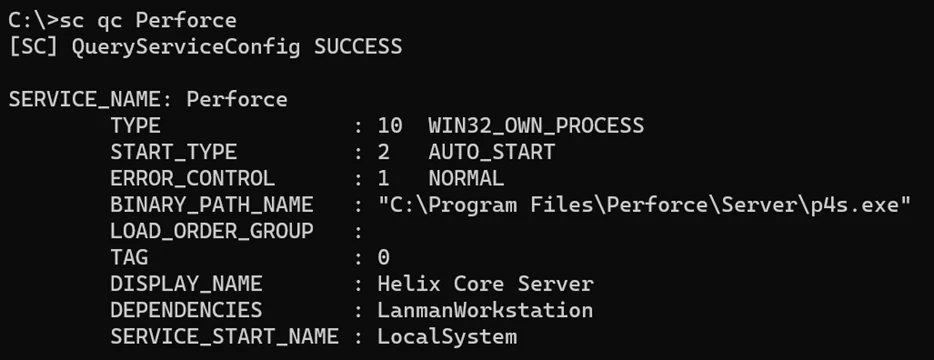
Recovering debug symbols
In 2014, Perforce open-sourced the code for their CLI Perforce Client, and informed users we can download the code from the bin.tools subdirectory of any given release. While having any source code is invaluable for application security vulnerability research purposes, this source code is specific to the client, not the server. The latter is only distributed in compiled binary form.
The binaries that are installed by Perforce Server’s installer have their debug symbols stripped (removed from the distributed executable images), which makes it harder to understand the disassembled code during static analysis. To aid our review, we attempted to recover these debug symbols.
Discovering debug symbols
Sometimes applications offer software development kits (SDKs) that can be mined for debug symbol data. In the case of Perforce Server, Perforce offers a “C/C++ API” package for the Windows (x64) platform that comes in the form of a .zip file containing three directories: include, lib, and sample. The lib directory is especially interesting for us, as it contains about 400 MB of .lib files:
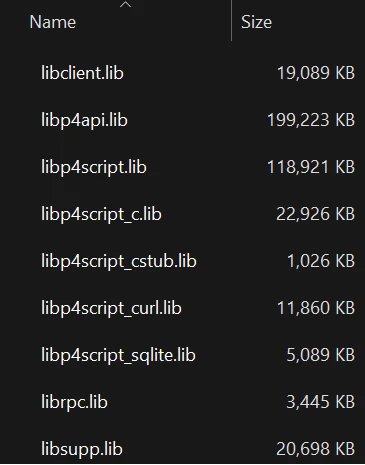
Like .exe files, .lib files are COFF files that can contain debug symbols. By using dumpbin.exe /symbols to inspect each .lib file, we found that the nine .lib files in the package contain a total of 1,251,756 debug symbol entries.
To understand why this is useful to us, let us consider an approximation of how .exe and .lib files are built:
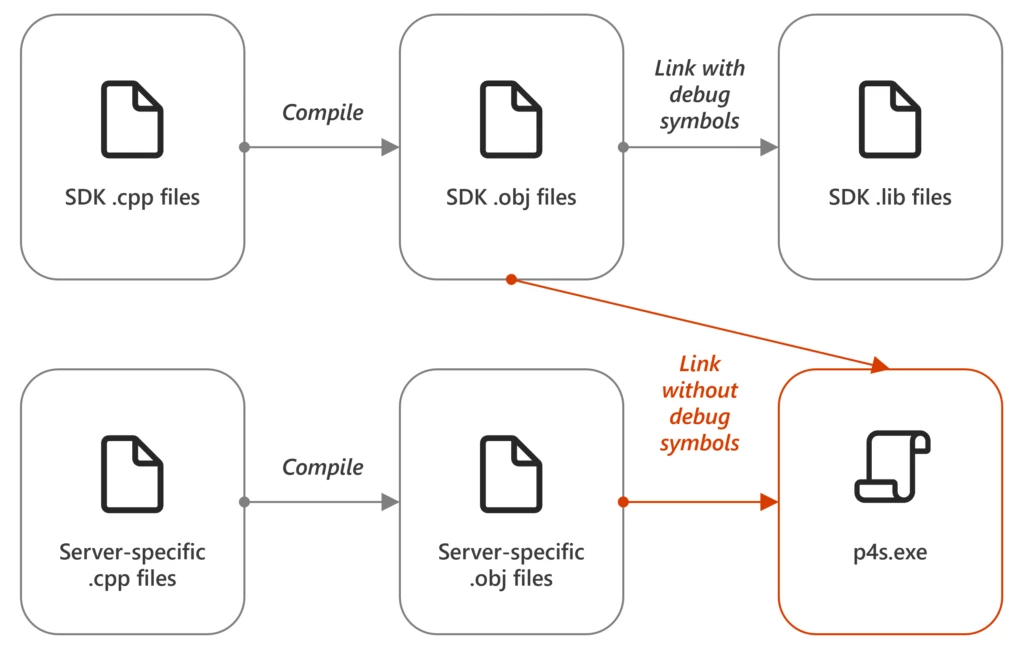
In the diagram above, we can see that the SDK .obj files were linked along with server-specific .obj files to create Perforce Server’s p4s.exe (“Perforce Service”) file. During that linking process, the debug symbols were stripped. However, the same SDK .obj files had their debug symbols retained when linked into the SDK .lib files. Since the .lib files contain debug symbols, we can match each compiled SDK function in each .lib file to its SDK function name. If we can then find those same compiled SDK functions in Perforce Server’s .exe and .dll files, we can map the SDK function names to those functions as well, thus simplifying our analysis of the p4s.exe file.
To begin, we must first determine which SDK package to use for our analysis. If we look at the containing directory for the .zip file downloaded from the “C/C++ API” package, we see it contains 144 p4api SDK packages:
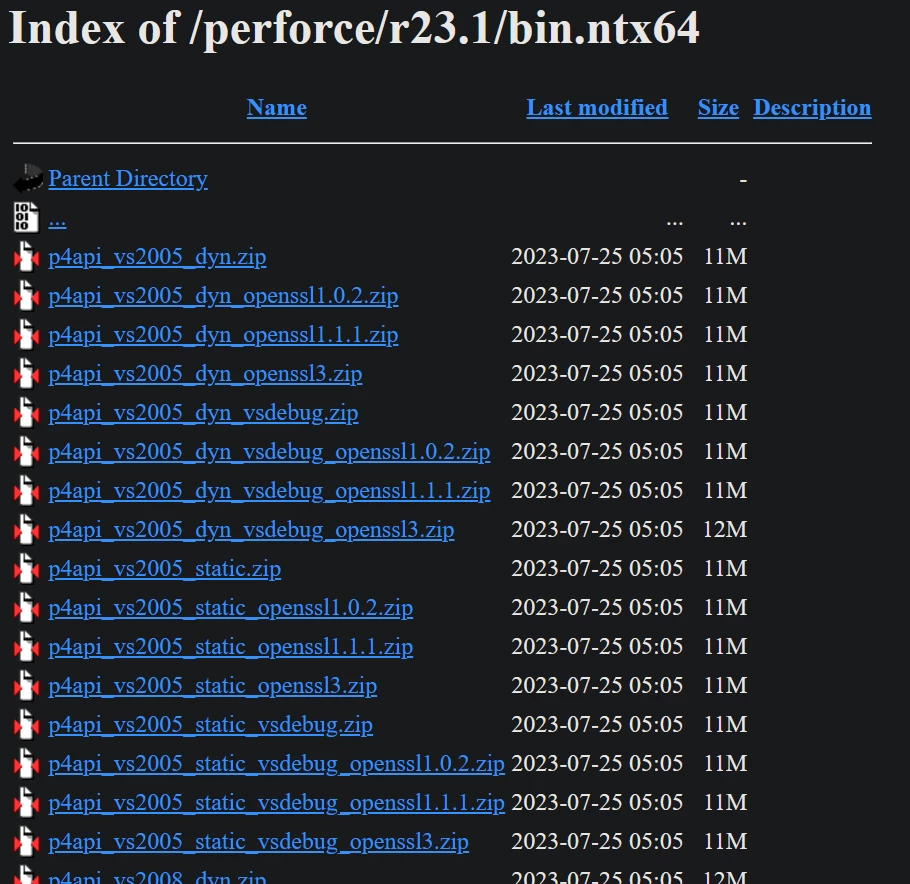
The reason we see 144 packages listed is that there is every combination of the following:
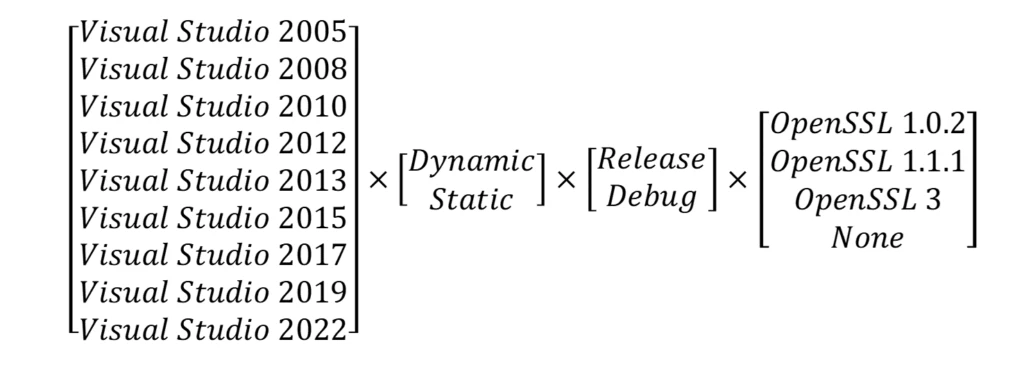
That’s nine possible values for compiler, two possible values for linking, two possible values for build type, and four possible values for OpenSSL version. In other words, multiplying those four values together leads us to 144 possible combinations. To map named functions from the SDK’s .lib files to Perforce Server’s p4s.exe file, we’ll need to choose the correct SDK package, since, for example, a function compiled with Visual Studio 2005 may look very different from the same function compiled with Visual Studio 2022.
So how do we know which compiler, linker option, build type, and OpenSSL version were used for our installed distribution of Perforce Server? We don’t. We could make some educated guesses and examine artifacts such as the binaries’ Rich Headers to determine the right combination, but instead we chose to use automation to test all possible combinations. (Note that “Rich Headers” is a colloquial term used in the industry, not a Microsoft-official name for this structure.)
Finding the right set of debug symbols
After downloading all of the statically linked p4api archives from Perforce’s website, we used IDA Pro’s F.L.I.R.T. technology to create signatures for each Perforce Server SDK package. To do so, we automated the following steps:
- Use pcf.exe (“parsecoff”) from IDA Pro’s Fast Library Acquisition for Identification and Recognition (FLAIR) SDK to create .pat (“pattern”) files for each Perforce Server SDK package’s .lib file.
- Use sigmake.exe from the FLAIR SDK to create a .sig (“signature”) file for all the .pat files from each given Perforce Server SDK package.
- Use zipsig.exe from the FLAIR SDK to compress each .sig file.
- Disassemble Perforce Server’s p4s.exe file with IDA Pro and save the resulting .idb (“IDA database”) file.
- For each .sig file, open the .idb file, apply the .sig file, count the number of .sig file function matches, and close the .idb file without saving the modifications.
- Rank the number of function matches for each .sig file.
After following the process above, we found the debug symbols from p4api_vs2017_static_openssl1.1.1.zip had the most function matches in p4s.exe:
| Function Matches | Signature File |
| 11,928 | p4api_vs2017_static_openssl1.1.1_p4api-2023.1.2468153-vs2017_static.sig |
| 11,887 | p4api_vs2017_static_openssl3_p4api-2023.1.2468153-vs2017_static.sig |
| 11,847 | p4api_vs2017_static_openssl1.0.2_p4api-2023.1.2468153-vs2017_static.sig |
| 11,847 | p4api_vs2017_static_p4api-2023.1.2468153-vs2017_static.sig |
| 10,228 | p4api_vs2017_static_vsdebug_openssl1.1.1_p4api-2023.1.2468153-vs2017_static_vsdebug.sig |
| 10,187 | p4api_vs2017_static_vsdebug_openssl3_p4api-2023.1.2468153-vs2017_static_vsdebug.sig |
| 10,147 | p4api_vs2017_static_vsdebug_openssl1.0.2_p4api-2023.1.2468153-vs2017_static_vsdebug.sig |
| 10,147 | p4api_vs2017_static_vsdebug_p4api-2023.1.2468153-vs2017_static_vsdebug.sig |
| 8,222 | p4api_vs2019_static_openssl1.1.1_p4api-2023.1.2468153-vs2019_static.sig |
| 8,195 | p4api_vs2019_static_openssl3_p4api-2023.1.2468153-vs2019_static.sig |
| 8,167 | p4api_vs2019_static_openssl1.0.2_p4api-2023.1.2468153-vs2019_static.sig |
| 8,167 | p4api_vs2019_static_p4api-2023.1.2468153-vs2019_static.sig |
| 7,804 | p4api_vs2019_static_vsdebug_openssl1.1.1_p4api-2023.1.2468153-vs2019_static_vsdebug.sig |
| 7,777 | p4api_vs2019_static_vsdebug_openssl3_p4api-2023.1.2468153-vs2019_static_vsdebug.sig |
| 7,749 | p4api_vs2019_static_vsdebug_openssl1.0.2_p4api-2023.1.2468153-vs2019_static_vsdebug.sig |
| 7,749 | p4api_vs2019_static_vsdebug_p4api-2023.1.2468153-vs2019_static_vsdebug.sig |
| 5,818 | p4api_vs2022_static_openssl1.1.1_p4api-2023.1.2468153-vs2022_static.sig |
| 5,802 | p4api_vs2022_static_openssl3_p4api-2023.1.2468153-vs2022_static.sig |
| 5,784 | p4api_vs2022_static_openssl1.0.2_p4api-2023.1.2468153-vs2022_static.sig |
| 5,784 | p4api_vs2022_static_p4api-2023.1.2468153-vs2022_static.sig |
| 5,525 | p4api_vs2022_static_vsdebug_openssl1.1.1_p4api-2023.1.2468153-vs2022_static_vsdebug.sig |
| 5,509 | p4api_vs2022_static_vsdebug_openssl3_p4api-2023.1.2468153-vs2022_static_vsdebug.sig |
| 5,491 | p4api_vs2022_static_vsdebug_openssl1.0.2_p4api-2023.1.2468153-vs2022_static_vsdebug.sig |
| 5,491 | p4api_vs2022_static_vsdebug_p4api-2023.1.2468153-vs2022_static_vsdebug.sig |
| 1,639 | p4api_vs2015_static_openssl1.1.1_p4api-2023.1.2468153-vs2015_static.sig |
| 1,639 | p4api_vs2015_static_vsdebug_openssl1.1.1_p4api-2023.1.2468153-vs2015_static_vsdebug.sig |
| 1,630 | p4api_vs2015_static_openssl1.0.2_p4api-2023.1.2468153-vs2015_static.sig |
| 1,630 | p4api_vs2015_static_p4api-2023.1.2468153-vs2015_static.sig |
| 1,630 | p4api_vs2015_static_vsdebug_openssl1.0.2_p4api-2023.1.2468153-vs2015_static_vsdebug.sig |
| 1,630 | p4api_vs2015_static_vsdebug_p4api-2023.1.2468153-vs2015_static_vsdebug.sig |
| 1,628 | p4api_vs2015_static_openssl3_p4api-2023.1.2468153-vs2015_static.sig |
| 1,628 | p4api_vs2015_static_vsdebug_openssl3_p4api-2023.1.2468153-vs2015_static_vsdebug.sig |
| 1,042 | p4api_vs2013_static_openssl1.1.1_p4api-2023.1.2468153-vs2013_static.sig |
| 1,041 | p4api_vs2013_static_vsdebug_openssl1.1.1_p4api-2023.1.2468153-vs2013_static_vsdebug.sig |
| 1,040 | p4api_vs2013_static_openssl1.0.2_p4api-2023.1.2468153-vs2013_static.sig |
| 1,040 | p4api_vs2013_static_p4api-2023.1.2468153-vs2013_static.sig |
| 1,039 | p4api_vs2013_static_vsdebug_openssl1.0.2_p4api-2023.1.2468153-vs2013_static_vsdebug.sig |
| 1,039 | p4api_vs2013_static_vsdebug_p4api-2023.1.2468153-vs2013_static_vsdebug.sig |
| 1,033 | p4api_vs2013_static_openssl3_p4api-2023.1.2468153-vs2013_static.sig |
| 1,032 | p4api_vs2013_static_vsdebug_openssl3_p4api-2023.1.2468153-vs2013_static_vsdebug.sig |
| 973 | p4api_vs2012_static_openssl1.1.1_p4api-2023.1.2468153-vs2012_static.sig |
| 972 | p4api_vs2012_static_vsdebug_openssl1.1.1_p4api-2023.1.2468153-vs2012_static_vsdebug.sig |
| 971 | p4api_vs2012_static_openssl1.0.2_p4api-2023.1.2468153-vs2012_static.sig |
| 971 | p4api_vs2012_static_p4api-2023.1.2468153-vs2012_static.sig |
| 970 | p4api_vs2012_static_vsdebug_openssl1.0.2_p4api-2023.1.2468153-vs2012_static_vsdebug.sig |
| 970 | p4api_vs2012_static_vsdebug_p4api-2023.1.2468153-vs2012_static_vsdebug.sig |
| 967 | p4api_vs2012_static_openssl3_p4api-2023.1.2468153-vs2012_static.sig |
| 966 | p4api_vs2012_static_vsdebug_openssl3_p4api-2023.1.2468153-vs2012_static_vsdebug.sig |
| 838 | p4api_vs2010_static_openssl1.1.1_p4api-2023.1.2468153-vs2010_static.sig |
| 838 | p4api_vs2010_static_vsdebug_openssl1.1.1_p4api-2023.1.2468153-vs2010_static_vsdebug.sig |
| 837 | p4api_vs2010_static_openssl1.0.2_p4api-2023.1.2468153-vs2010_static.sig |
| 837 | p4api_vs2010_static_p4api-2023.1.2468153-vs2010_static.sig |
| 837 | p4api_vs2010_static_vsdebug_openssl1.0.2_p4api-2023.1.2468153-vs2010_static_vsdebug.sig |
| 837 | p4api_vs2010_static_vsdebug_p4api-2023.1.2468153-vs2010_static_vsdebug.sig |
| 833 | p4api_vs2010_static_openssl3_p4api-2023.1.2468153-vs2010_static.sig |
| 833 | p4api_vs2010_static_vsdebug_openssl3_p4api-2023.1.2468153-vs2010_static_vsdebug.sig |
| 495 | p4api_vs2008_static_openssl1.1.1_p4api-2023.1.2468153-vs2008_static.sig |
| 495 | p4api_vs2008_static_vsdebug_openssl1.1.1_p4api-2023.1.2468153-vs2008_static_vsdebug.sig |
| 494 | p4api_vs2008_static_openssl1.0.2_p4api-2023.1.2468153-vs2008_static.sig |
| 494 | p4api_vs2008_static_p4api-2023.1.2468153-vs2008_static.sig |
| 494 | p4api_vs2008_static_vsdebug_openssl1.0.2_p4api-2023.1.2468153-vs2008_static_vsdebug.sig |
| 494 | p4api_vs2008_static_vsdebug_p4api-2023.1.2468153-vs2008_static_vsdebug.sig |
| 490 | p4api_vs2008_static_openssl3_p4api-2023.1.2468153-vs2008_static.sig |
| 490 | p4api_vs2008_static_vsdebug_openssl3_p4api-2023.1.2468153-vs2008_static_vsdebug.sig |
| 440 | p4api_vs2005_static_openssl1.1.1_p4api-2023.1.2468153-vs2005_static.sig |
| 440 | p4api_vs2005_static_vsdebug_openssl1.1.1_p4api-2023.1.2468153-vs2005_static_vsdebug.sig |
| 439 | p4api_vs2005_static_openssl1.0.2_p4api-2023.1.2468153-vs2005_static.sig |
| 439 | p4api_vs2005_static_p4api-2023.1.2468153-vs2005_static.sig |
| 439 | p4api_vs2005_static_vsdebug_openssl1.0.2_p4api-2023.1.2468153-vs2005_static_vsdebug.sig |
| 439 | p4api_vs2005_static_vsdebug_p4api-2023.1.2468153-vs2005_static_vsdebug.sig |
| 435 | p4api_vs2005_static_openssl3_p4api-2023.1.2468153-vs2005_static.sig |
| 435 | p4api_vs2005_static_vsdebug_openssl3_p4api-2023.1.2468153-vs2005_static_vsdebug.sig |
The remainder of this blog post leverages these signatures for p4s.exe’s function names and type information.
Investigating the RPC header
Given that Perforce Server runs as LocalSystem, local elevation of privilege attacks would certainly be worthwhile to explore. However, remote attacks via a network are much more intriguing from a vulnerability research perspective. Our next step is to investigate how Perforce Server handles data it receives from remote users, or in our case, attackers.
Using TCPView, we can see that p4s.exe is listening for incoming connections on TCP port 1666:

Programs built for Windows that listen on TCP ports for incoming connections almost always use Winsock’s recv() function to receive incoming network data from clients. Using IDA Pro’s cross-references (“CODE XREF”s below), we can see that recv() is called by several functions:

We’re looking to assess how received network data is parsed and handled, and to save time in determining which of the functions above actually receives the connected client data via recv(), we used a debugger to set a breakpoint on recv() and reviewed its thread’s call-stack to reveal the following chain of function calls:
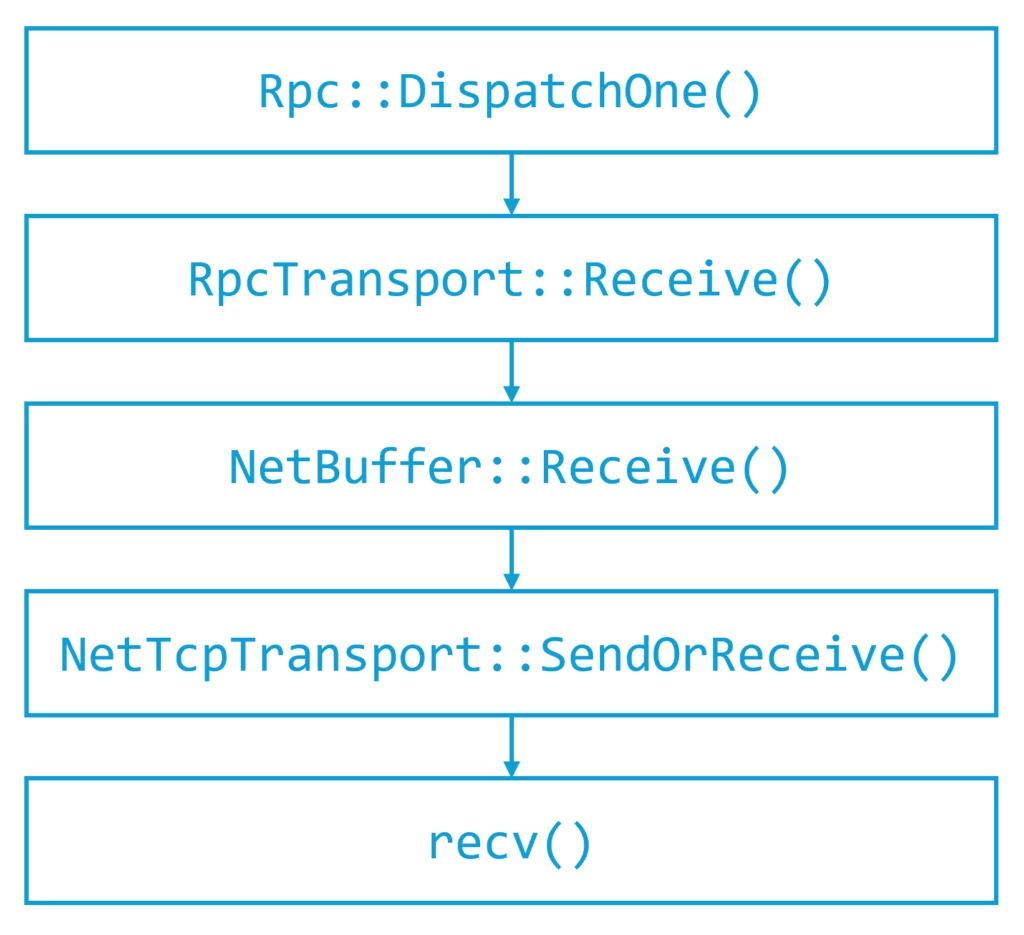
In the call-stack above, “Rpc” is short for “Remote Procedure Call”, a common term used for remotely executing functions.
Although we’re assessing the Perforce Server, the function RpcTransport::Receive() (in Figure 8) is also included in the client source code discussed above (note that the comments are from Perforce’s developers, not from Microsoft):
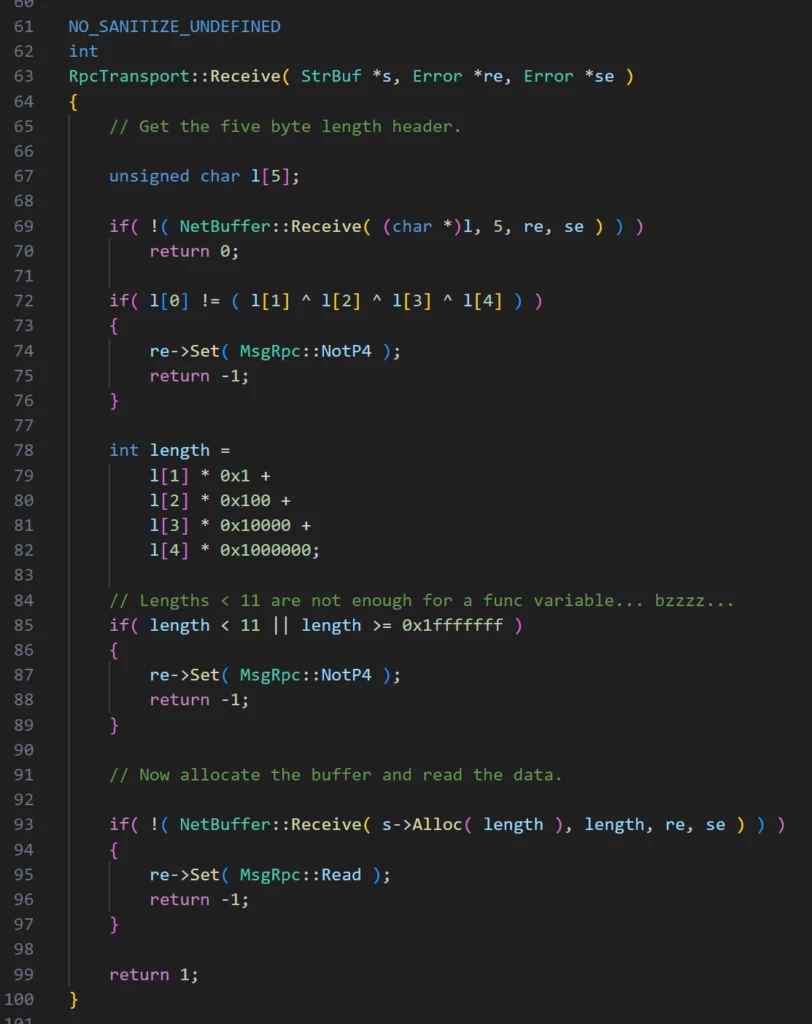
The code above does the following:
- On line 69, calls NetBuffer::Receive() to receive five bytes of data from the connected TCP client. We will refer to these five bytes as the RPC header.
- On line 72, verifies that the first byte’s value equals the value of the following four bytes using the XOR operation to compute a parity byte checksum.
- On line 78, interprets those following four bytes as a 32-bit little-endian value named length.
- On line 85, verifies that length >= 12 and that length < 0x1FFFFFFF.
- On line 93, allocates memory of size length and receives length bytes from the connected TCP client.
However, there’s a design risk in the code above, in that there’s not sufficient protection against asymmetric resource consumption attacks from remote unauthenticated attackers. An attacker could connect to the Perforce Server, send a five-byte RPC header specifying a length value of 0x1FFFFFFE, and cause the server to allocate 0x1FFFFFFE bytes (about 537 MB) of memory. An attacker could exploit this vulnerability by establishing numerous connections and requesting these large memory allocations via each connection, quickly consuming all the server’s available memory. Once available memory is exhausted, the next call to Alloc() (step 5 above) will lead Perforce Server’s memory allocator (which happens to be mimalloc) to throw an unhandled std::bad_alloc() exception from mi_try_new_handler(), causing the Perforce Server process to crash and not restart. This denial-of-service (DoS) attack is exploitable by remote unauthenticated attackers.
This vulnerability is now identified as CVE-2023-5759 and it has a CVSS score of 7.5.
Investigating RPC handler functions
We showed in the call-stack above that RpcTransport::Receive() is called by Rpc::DispatchOne(). This latter function takes the allocated buffer received by RpcTransport::Receive(), parses it as an RPC command with optional arguments, looks up the handler for the given RPC command, and calls the handler with the received arguments. Many of these RPC commands are mapped to the p4 commands listed here. Specifically, there are 202 formally documented p4 commands, and about 450 defined RPC commands, though not all RPC commands have their handlers registered by default at runtime.
Since we’re most interested in the possibility of remote unprivileged attacks against Perforce Server in its default configuration, we created our own Perforce client from scratch that attempts to call (without any authentication) each of the approximately 450 RPC commands defined in p4s.exe. Of those, we found that about 360 RPC commands have their handlers registered by default at runtime. This is too high of a count to manually assess in a reasonable amount of time, so we had to find other means to prioritize our RPC command analysis.
We found that p4s.exe statically imports 382 API functions. Of those, we identified the most interesting functions that could potentially achieve remote code execution, assuming an unauthenticated remote attacker could both execute an RPC function that calls one of these API functions and control the arguments to that API function. These functions are:
- CreateFileMapping()
- CreateProcess()
- DeviceIoControl()
- LoadLibrary()
- LoadLibraryEx()
- MapViewOfFile()
- MoveFileEx()
- RegSetValueEx()
- ShellExecuteEx()
- WriteFile()
Assessing this short list of API functions and analyzing code-flow paths from RPC handlers to these functions was a much more tractable problem than manually reviewing each of the approximately 360 registered RPC handlers.
The bgtask command
By reviewing cross-references with IDA Pro, we were able to identify the following call-chain from an RPC command handler to CreateProcess():
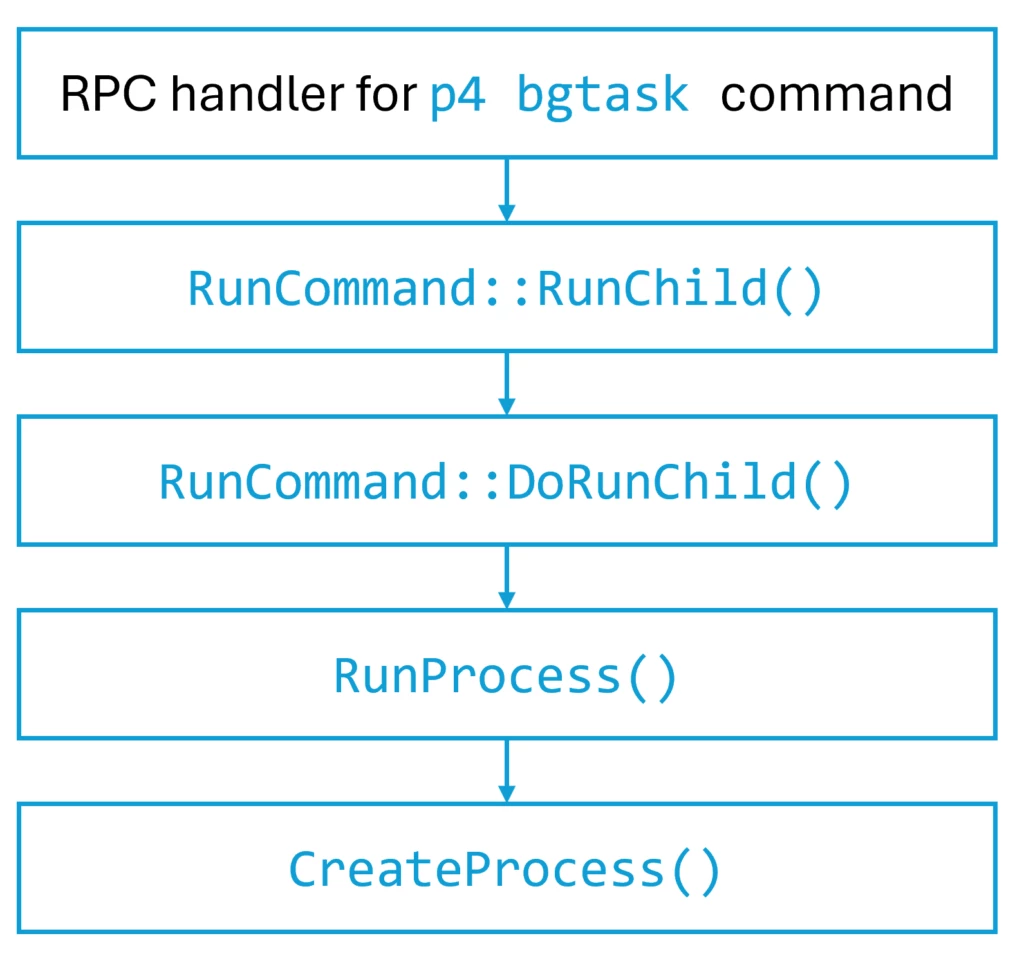
According to Perforce’s documentation, the p4 bgtask command “enables a Helix Core superuser on the p4 command-line client to run commands or programs remotely on the server in the background.” It’s thus not surprising that this type of command would end up calling CreateProcess(), but since the documentation states that this command can only be run by a superuser, our only hope of finding a security vulnerability here was if there was a bug in the authentication component or in how the RPC arguments were getting parsed.
To begin our assessment of p4 bgtask, we used the custom Perforce client that we wrote to see how the server would respond if we tried remotely calling bgtask without any authentication. To our surprise, the server didn’t return any errors. In fact, the server ran the command line that we sent to it, and this child process ran as LocalSystem.
Upon further investigation, this is by design, with the manual noting to “Run p4 protect immediately after installing Helix Server for the first time. Before the first call to p4 protect, every Helix Server user is a superuser and thus can access and change anything in the depot”. In this context, “every Helix Server user” also includes unauthenticated anonymous remote users.
If an administrator does not manually perform those post-installation steps, this missing authentication for a critical function allows unauthenticated remote attackers to run arbitrary command lines (including PowerShell command lines with script blocks) as LocalSystem when Perforce Server is installed with its default configuration.
This vulnerability is now identified as CVE-2023-45849 and it has a CVSS score of 10.0.
The rmt-Shutdown RPC handler
When a user (or attacker) uses the p4 bgtask discussed above with the standard Perforce Client, the client sends the RPC command name user-bgtask to the server to execute that command. However, some RPC command names that are accepted by the server don’t have a corresponding Perforce Client command; one of those RPC command names is rmt-Shutdown.
Although it’s not possible to send the rmt-Shutdown RPC command with the standard Perforce Client (nor the Perforce Admin Tool), and it doesn’t appear to be documented on Perforce’s website, we were able to send the command with our custom Perforce client. We found that the handler for rmt-Shutdown requires a username of remote but doesn’t require any authentication credentials for that username. When the Perforce Server receives this command, it terminates the Perforce Server process, thereby allowing unauthenticated remote attackers to perform DoS attacks against the server.
This vulnerability is now identified as CVE-2023-35767 and it has a CVSS score of 7.5.
The rmt-UpdtFovrCommit RPC handler
Similar to the rmt-Shutdown RPC command name, the RPC command name rmt-UpdtFovrCommit (which is likely short for “remote update failover commit”) cannot be sent via the standard Perforce Client nor Admin Tool and doesn’t appear to be documented on Perforce’s website but can be sent with a custom Perforce client. This RPC function piqued our interest when we first tested for registered RPC handlers, since when our custom-built scanner sent a rmt-UpdtFovrCommit RPC command as an anonymous user and without any command arguments to the Perforce Server, the Perforce Server process crashed.
We can see the reason for the crash in the decompiled rmt-UpdtFovrCommit handler code below:
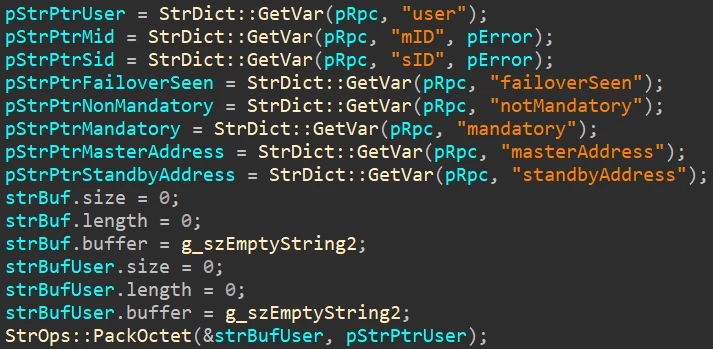
As previously discussed, RPC messages sent from the client to the server contain the RPC function name and can optionally contain RPC function arguments. In the code above, StrDict::GetVar() is used to get the client’s RPC function arguments from the pRpc object. If the given argument name was not provided in the client’s RPC message, then StrDict::GetVar() returns zero. In the first line above, StrDict::GetVar() is used to get the value of the user RPC function argument. However, if the user (or attacker) does not specify a value for user in their RPC message then pStrPtrUser gets set to zero. In the last line above, we see pStrPtrUser passed as the second argument to StrOps::PackOctet(), (the source code for which is available in the client source code discussed above):
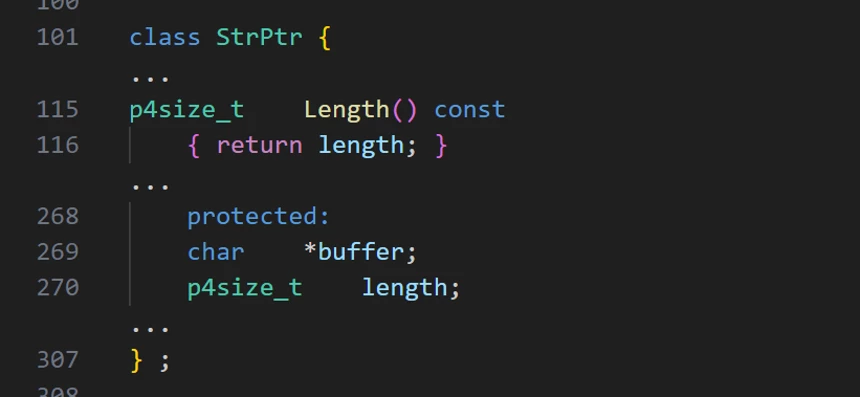


As can be seen in the code above, when StrOps::PackOctet() is called with zero as the value for s, StrBuf::Append() gets called with zero as the value for t. This results in StrBuf::Append() trying to dereference the length field of t, where the buffer field of t is at offset 0 relative to the beginning of the t object and the length field of t is at offset 8 relative to the beginning of the t object (since char *buffer is 64-bits). When the value of t is 0, dereferencing length leads to reading from virtual memory address 0x0000000000000008, which results in a read-access violation or segmentation fault. We found that these types of exceptions are not handled gracefully by the server and that such read-exceptions cause the entire server process to crash and not restart. This DoS attack is exploitable by remote unauthenticated attackers.
This vulnerability is now identified as CVE-2023-45319 and it has a CVSS score of 7.5.
Coordinated disclosure
Microsoft reported these four security vulnerabilities to the vendor Perforce at the end of August 2023. Immediately afterwards, on September 1, Perforce acknowledged these four vulnerabilities and began work to investigate and remediate them. Throughout September and October, Perforce communicated status updates to Microsoft on implementing fixes and putting those fixes through their QA processes. Perforce reserved CVE IDs on October 24, 2023, shared those IDs with Microsoft on October 25, 2023, and informed Microsoft at that time that the patches would be published by mid-November 2023. On November 7, 2023, Perforce published Perforce Server version 2023.1/2513900, which mitigates these four vulnerabilities.
Microsoft would like to thank Perforce for their professionalism and for their rapid response in addressing these security vulnerabilities. Microsoft is grateful for this partnership and for Perforce’s commitment to security.
Mitigation and protection guidance
Microsoft is not aware of any adversaries exploiting these vulnerabilities, but mitigations should be applied by all Perforce Server customers as soon as possible.
Risk detection
Extend vulnerability and risk detection beyond the firewall with platforms like Microsoft Defender External Attack Surface Management. Customers can identify internet-exposed infrastructure running Perforce Server in their inventory and use the insights tile under the Attack Surface Summary dashboard to surface assets vulnerable to CVE-2023-5759, CVE-2023-45849, CVE-2023-35767, and CVE-2023-45319.
What to do now if you’re affected
Update to version 2023.1/2513900 immediately, available here: https://www.perforce.com/downloads/helix-core-p4d.
Defense-in-depth
In addition to following Perforce’s guidance on “Securing the server”, Microsoft recommends adhering to the following defense-in-depth tactics to minimize the risk of exploitation of these or other Perforce Server vulnerabilities.
- Regularly monitor for and apply patches for third-party software.
- Use a VPN and/or an IP allow-list to limit who can communicate with your Perforce Server.
- Issue TLS certificates to legitimate Perforce users and use a TLS termination proxy in front of Perforce Server to validate client’s TLS certificates before allowing them to connect to Perforce Server.
- Log all access to your Perforce Server, both via your network appliances and via Perforce Server itself.
- Configure alerting to notify IT administrators and your security team if the Perforce Server process crashes.
- Use network segmentation to ensure that if your Perforce Server is compromised, an attacker’s ability to pivot in your network is limited.
Appendix
Threat intelligence reports
Microsoft customers can use the following reports in Microsoft products to get the most up-to-date information about the threat actor, malicious activity, and techniques discussed in this blog. These reports provide intelligence, protection information, and recommended actions to prevent, mitigate, or respond to associated threats found in customer environments.
Microsoft Defender Threat Intelligence
Microsoft 365 Defender Threat analytics
Jason Geffner
Microsoft Threat Intelligence Community
References
- https://cve.mitre.org/cgi-bin/cvename.cgi?name=CVE-2023-5759
- https://cve.mitre.org/cgi-bin/cvename.cgi?name=CVE-2023-35767
- https://cve.mitre.org/cgi-bin/cvename.cgi?name=CVE-2023-45319
- https://cve.mitre.org/cgi-bin/cvename.cgi?name=CVE-2023-45849
- https://ftp.perforce.com/perforce/r23.1/bin.ntx64/
- https://portal.perforce.com/s/article/3925
- https://swarm.workshop.perforce.com/projects/perforce_software-p4
- https://www.perforce.com/downloads/administration-tool
- https://www.perforce.com/downloads/helix-command-line-client-p4
- https://www.perforce.com/downloads/helix-core-c/c-api
- https://www.perforce.com/downloads/helix-core-p4d
- https://www.perforce.com/manuals/cmdref/Content/CmdRef/commands.html
- https://www.perforce.com/manuals/p4sag/Content/P4SAG/protections.when_to_set.html
- https://www.perforce.com/press-releases/perforce-open-sources-popular-version-control-tools
Acknowledgments
Microsoft would like to recognize https://www.keysight.com/blogs/tech/nwvs/2022/06/08/a-sneak-peek-into-the-protocol-behind-perforce for previous work done in analyzing Perforce’s RPC protocol.
Learn more
For the latest security research from the Microsoft Threat Intelligence community, check out the Microsoft Threat Intelligence Blog: https://aka.ms/threatintelblog.
To get notified about new publications and to join discussions on social media, follow us on Twitter at https://twitter.com/MsftSecIntel.
To hear stories and insights from the Microsoft Threat Intelligence community about the ever-evolving threat landscape, listen to the Microsoft Threat Intelligence podcast: https://thecyberwire.com/podcasts/microsoft-threat-intelligence.
The post Patching Perforce perforations: Critical RCE vulnerability discovered in Perforce Helix Core Server appeared first on Microsoft Security Blog.